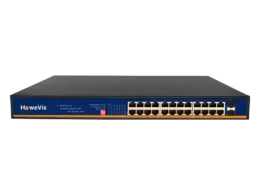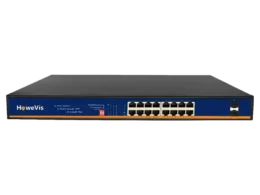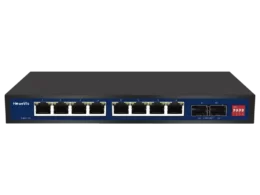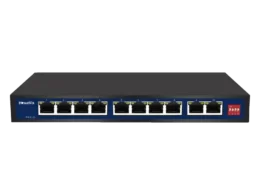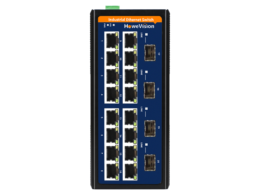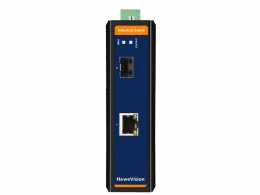For a basic understanding, Power over Ethernet is a system that transmits electrical power through Ethernet cables. What makes PoE stand out is its combination of data transmission alongside power supply. The technology uses power-sourcing equipment to source power and supplies direct current to the powered device through a standard Ethernet cable.
Will PoE work through a Switch? That issue lies in first answering what a switch is and its relevance in PoE technology. Here a switch, specifically a PoE switch, is a network switch that supports Power over Ethernet. Its purpose is to transmit power and data to compatible devices. In carrying out this purpose, it first detects whether or not the device is PoE compliant by introducing a lower voltage. It also determines by classification what voltage of power the device needs to function effectively and then goes ahead to supply that voltage. So, you have your answer! Yes, PoE will work through a switch.
This article considers the PoE Mechanism, whether PoE will work through a switch and how, differences between PoE switches and Regular switches, PoE switch and non-PoE devices, and benefits and Drawbacks. I have broken all of the above down to make it as easy to understand as possible.
How PoE Works: the mechanism
PoE typically works through cables that are in four pairs. Two of these network cable pairs enable you to send information in 10 and 100BASE-T Ethernet. These pairs are data pairs. The remaining pairs are the spare pairs, and they are free, and not saddled with any tasks. However, you need to know that this is only so in 10 and 100BASE-T Ethernet since Gigabit Ethernet utilizes all four pairs for transmission. Through the PoE mechanism, the two conductors who deliver electrical power across the cables work in synergy as one. PoE treats each of the two data pairs or the two spare pairs that transmit power across the system as one conductor.
Since you need an enormous voltage level to ensure an adequate power transmission through these cables, the device uses a voltage tottering between 45 and 57 volts. This amount of power ensures that the power transfer is efficient while maintaining the safety of your devices and the entire system. Although this voltage is safe for you and your devices, it may cause serious harm to non-compliant devices. Thus, the trick to preventing such grievous damage to vital equipment is to automatically detect whether the powered device (PD) is PoE compliant or not. The power sourcing equipment, which is the PoE switch, carries out this process. The Switch performs this procedure with a milder voltage, and the outcome of this IEEE compatibility test determines whether the control can apply a higher voltage safely. After this, the PD device undertakes a power classification process through which it detects and accordingly informs the Power Sourcing Equipment what amount of power it requires to function efficiently.
Finally, the user is to enable a power supply. The PSE delivers the requisite amount of power to the PD through the cables. It also monitors the energy of the device and keeps it at par with the PD’s demand. In doing this, the PSE fills up any deficits while cutting down surplus power. A voltage of 48 is usually maintained. The reason for this monitoring is apparent: to protect the equipment from power overload and possible harm.
Distinguishing between PoE switches and Regular switches
Beyond understanding the benefits that a PoE switch offers users, a sound understanding of the differences between PoE and Regular controls will aid you in no small way. The difference between the both is fundamental. Ordinarily, a regular switch cannot supply power over the internet, while a PoE switch does this by default. You see why it is called a POWER OVER ETHERNET switch, right? In addition to Data, it transmits power also through one Ethernet cable while Regular switches, on the other hand, transmit only data. Both have Ethernet ports that enable them to connect devices with Ethernet cables.
However, connecting a PoE injector or splitter bridges the gap this difference creates. There are four significant areas in which we can distinguish the two kinds of Switch: Power, Installation, Safety, and security.
- Power Supply: The PoE switch has four Ethernet ports for Network or signal transmission. Behind the Switch is an outlet through which the user connects to the PSE. When you join the PSE to the Switch through the outlet, it powers up the Switch, and the Switch can now supply power to the PD. However, the regular Switch does not require as much energy since it is unnecessary to provide power to other devices, so you can power it up by connecting it to the power source.
- Safety and Security: The PoE switch supplies power of about 48 to 55 watts. This voltage guarantees the safety of both the user and the equipment. A regular switch, however, powers on a 12-volt DC. This voltage is also safe, especially for the plastic materials involved in the entire process, as there is little or no chance of accidents occurring.
- Installation: Most of the time, users install networks in their homes using regular switches. Thus, Regular controls transfer Wi-Fi signals. The PoE switch is utilized mainly for the central or primary network system; unlike Regular switches, which transmit signals along with Wi-Fi/Wireless networks, PoE switches perform the same function through Ethernet cables and spread out the power and data the devices connected to the Network. Both are relatively easy to set up.
PoE switch and Non-Poe Devices
If you wonder whether a PoE switch can connect to or supply power to a non-PoE device, the answer is yes! PoE Switches work perfectly fine with non-PoE devices. You replace a regular switch with a Power over Ethernet switch if you have IP devices that require both data and power. The mechanics of this are simple and easy to understand: the standard PoE technology possesses a power transfer process which we describe as a Power handshake. It is the automatic detection process where the PoE switch detects whether or not your device is PoE compliant. If it is not, the Switch will work as a regular switch. The standard PoE technology only enables this detection. It is different if you use a passive PoE switch.
There are two kinds of IP devices, i.e., PoE and non-PoE devices. Non-PoE devices can only receive data from the PoE switch but, you will have to supply its power needs by connecting it directly to the power source. If your PoE switch cannot power your network devices, your first point of call is to check the instruction or description box on your network device to ensure that your device supports Power over Ethernet. Alternatively, you can reach out to the company’s customer service where you purchased your device and ask to confirm whether the device is PoE-enabled or not.
PoE Benefits and Drawbacks
From all the points we have discussed, the PoE technology, it is apparent that it has many benefits to offer. Before we look at why a PoE switch is the best for your business needs, let us consider some of the drawbacks of the technology.
- PoE Compatibility: All devices do not support Power over Ethernet. However, this is a minor issue that you can solve by introducing an Injector or a splitter.
- Power Rates: The IEEE 802.3 generation of your PoE device determines its power rate. You can sort out this drawback by carefully selecting the exact power budget that caters to your peculiar needs.
- Distance: The physical distance between the power source and the devices constitutes a restraint on data transmission, which is limited to a length of about 100 meters. You can set this limitation aside by using an Extender that expands the horizon to a length of 400 meters; thus, extinguishing the difficulties that the length limit foists on larger businesses.
Lots of benefits abound; some of which include:
- Massive productivity
- Better Responsiveness
- Cost-effectiveness
- Highly secure installation.
In our fast-paced technological world, keeping up with the ever-advancing technology and utilizing its benefits is probably the best decision you will make regarding your business. Find out the best PoE switch that will support your needs and watch your networking get even better.

